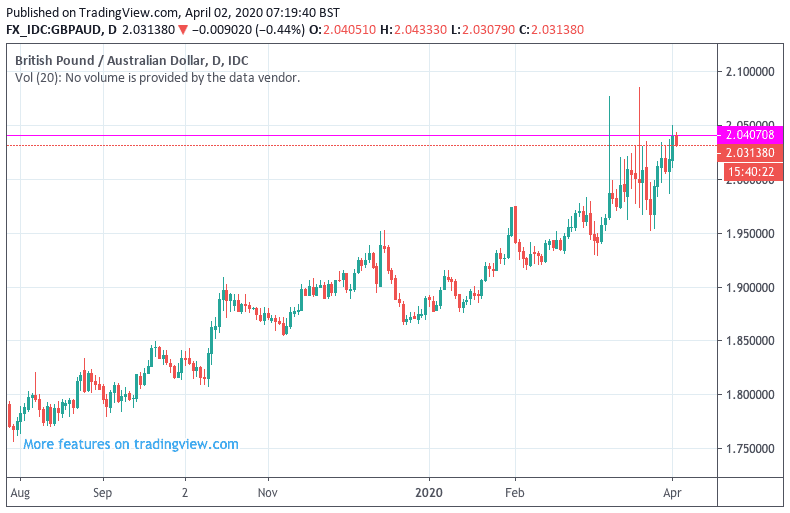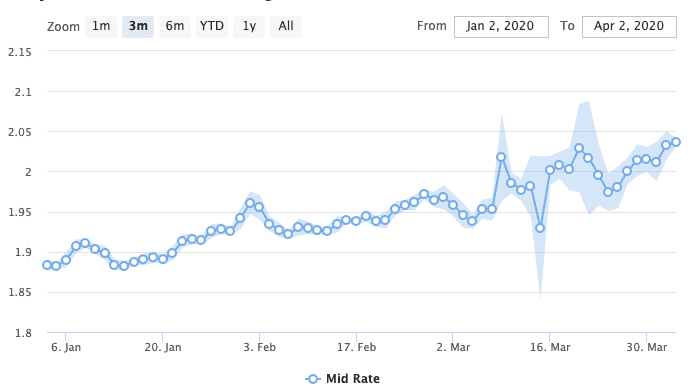Pound-Australian Dollar Exchange Rate Closes at Four-Year High, Forecast to Extend its Grinds Higher
- GBP/AUD uptrend intact
- AUD remains vulnerable to market weakness
- "global economic contraction will keep AUD and NZD on the back foot" - CBA

Image © Greg Brave, Adobe Stock
- GBP/AUD spot: 2.0313
- Bank transfer rates (indicative): 1.9603-1.9745
- FX specialist rates (indicative): 2.0130-1.9900 More information
Pound Sterling remains in a clearly defined upward trend against the Australian Dollar, that sees us maintain a bias towards further upside for the foreseeable future.
The Pound-to-Australian Dollar exchange rate on Wednesday closed at its highest level in four years at 2.040, the previous highest close was achieved on March 27 at 2.0198.
The price action in GBP/AUD is positive, as shown by the gentle uptrend that has been in place since July 2019. There is little technical evidence that the trend is fading and this advocates for further advances.
We are however aware that volatility has risen over the course of the past month, which is understandable considering the scale of the global market rout sparked by the coronavirus:
The increase in volatility should signal that daily price action is likely to be characterised by big moves in either direction, but given that the bigger picture suggests the Pound's uptrend remains intact we would be wary of reading too much into such volatility.
"Growing fears that prolonged shutdowns around the world will exacerbate the global economic contraction will keep AUD and NZD on the back foot in our view," says Joseph Capurso, FX Strategist at Commonwealth Bank of Australia. "We still expect AUD to fall."
The Australian Dollar continues to respect global investor sentiment and struggled on the first day of the new month amidst a fresh wave of selling in global stock markets.
Market sentiment remains shaky as investors opt to sit on the sidelines and await the economic fallout from the coronavirus to unfold, with attention now firmly on the U.S. which is at the epicentre of the global crisis.
"Florida, Pennsylvania and Mississippi have issued lock‑downs. And that will lock‑down a growing part of the US economy," says Capurso.
As long as global markets remain soft, we would expect the Australian Dollar to remain under pressure.
A slew of negative predictions and updates on the human and economic impact of the coronavirus is likely to be the main theme for financial markets for the foreseeable future. The global death toll has reached 43K and European countries from Germany to Italy are extending their lockdowns as the toll of the virus continues to climb.
"The market mood will likely remain clouded by undesirable news regarding the progress of the coronavirus spread in Europe and across the US. Despite WHO’s announcement that Europe may be approaching a peak, France and Spain recorded their deadliest days this week and we do not yet see a reversing pattern in cases and deaths. Meanwhile, fatalities in New York and New Jersey double up over the past three days. 2000 deaths were recorded in New York alone, and cases reported in the US were surprisingly younger than elsewhere," says Ipek Ozkardeskaya, a market analyst at Swissquote Bank.
With more U.S. states entering lockdown, and Europe no where near close to lifting restrictions, the economic impact remains difficult for markets to grasp.
There is simply very little for those investors looking to bet on a market recovery - that would ultimately help create the conditions for a broader Australian Dollar recovery - to grasp onto.
"The unfolding global contraction is poised to supplant the GFC as the new benchmark for extreme economic disruption – the current collapse in economic activity is much deeper within individual economies and is enveloping a much broader range of economies concurrently than was the case in the 2008 crash," says Daniel P Hui, a Strategist with investment bank JP Morgan.
The Australian Dollar has now fallen 13% against the Dollar and 6% against the Pound in 2020; and analysts at Australian lender Westpac see the potentail for further declines.
"AUD/USD to remain prey to global risk sentiment, occasionally probing 0.6150/70 but overall biased back towards 0.58 multi-week," says Sean Callow, Senior Currency Strategist at Westpac. "Official data in coming weeks will be depressing confirmation of recession, hardly the fuel for AUD recovery."
Westpac forecast "a shocking" -8.5% fall in economic output in the second quarter of 2020, while the unprecedented fiscal support offered by the Australian government should see the country's finances fall to a deficit of -5% of GDP in the year to June, blowing out to -10.5% in 2020/21, "the largest deficit since WW2," says Callow.






